Why is everywhere a "listening bar" now?
Poking at the flat aesthetic of the suddenly ubiquitous hi-fi watering holes
It seems that everyone I know has been to Japan in the last three years, thanks to the dual economic factors of a weak Yen and post-Covid revenge travel. Friends and acquaintances come back aglow from skiing, from the onsen hot springs, from the delicious 7-Eleven onigiri. They speak effusively about the cleanliness, the orderliness, the care and respect that goes into seemingly every public act in Japan. And I get it, I do. I have not been but I did shed a tear at the end of Wim Wenders’ Perfect Days when I saw it at a mostly empty Angelika Film Center.
We’re in a Japanophilic golden age. The craft and culture of the country wield significant influence over much of modern life and paint a certain aspirational picture for the young and city-dwelling. Nipponic trends abound, from coffee to interior design to $400 jeans. One of the more conspicuous of late is the appearance of “listening bars” in cities across America.
Conceptually, such places are inspired by the jazz kissa, a style of cafe in Japan dating back to the late 1920s which would serve tea and coffee and play imported jazz. Records weren’t produced in Japan until later in the 20th century so for a long time people couldn’t afford to buy them, let alone their own stereo system. Kissa met the ravenous appetite for jazz in the country, and after World War II they began to change shape to resemble more of what exists in our current consciousness: dimly lit rooms where patrons sip expensive whiskey and sit in quiet reverence to the music being played exceptionally loud from an expertly designed sound system.
A couple of years ago, I was talking on the phone with a friend who had just returned from a two-week trip which included stops at hi-fi bars in both Sapporo and Tokyo. He explained that the former, Precious Hall, took away his phone and put him in a room so dark that he felt the music was dissolving his ego. Upon his return to the States, this friend bemoaned the lack of anywhere standing up convincingly. Even Bar Shiru in Oakland, where he lived at the time, only swung in the direction of doing justice. Opened by husband and wife duo Shirin Raza and Daniel Gahr in 2019 as the Bay Area’s first hi-fi listening bar, Shiru was inspired by their own trip to Japan where they were “blown away” by the intimate spaces and exceptional audio quality, according to the bar’s website. Raza and Gahr’s bar emphasizes full-album sessions with jazz as a “jumping off point” to other genres, and allows patrons to converse “without raising their voice,” as a relaxed compromise of sorts.
The same friend recently came to New York and made a reservation for us at the much talked about All Blues in Tribeca. Standing in the foyer, our party of four were given a quick perfunctory rundown by the willowy maitre d': keep your voices down, basically. We were seated in the “theater,” a high-ceilinged box of a room with all seats facing the hulking speaker cabinets on stage. There was mention of an optional “audio tour” which I later requested. Our host returned and rattled off the make, model, and approximate value of the amps, receivers, and speakers surrounding us - collectively quite a bit more than it costs to raise a child in New York City. We ate edamame and spoke softly and while the obscure soul music was warm and kinetic, it also felt weirdly removed. Like it was trying to keep a polite distance from our table. At the point in the night when I was most enjoying myself, our host made her third appearance and asked us to keep it down.
This balance of homage versus replication, allowing conversation or forbidding it, seems to be at the heart of the disconnect between listening bars in Japan and the versions it has inspired elsewhere, particularly in the U.S. I was explaining my idea for this piece to another friend over beers at Cookie’s, a non-listening bar in Brooklyn. He pointed out very astutely that one of the deepest cultural divergences between America and Japan is the relationship to silence. Anyone who has been inside of a bar, restaurant, or even a library in America will know that quiet can be hard to come by. As I reached the bottom of my pint, I became distracted by “The Parasite (For Buffy)” from Eugene McDaniels’ Headless Heroes of the Apocalypse bellowing out of the speakers above the bar. I didn’t recognize the song so I asked my phone to identify it, holding it above my head to hear better.
Certain listening bars are facing the talking problem head-on by setting the stage for a more intentional experience. At Shibuya, in Seattle’s hip Ballard neighborhood, your reservation comes with a 30-minute window to get a drink and converse with fellow patrons after which you are ushered into the Hi-Fi Room (no drinks or shoes allowed) for the session. This more catholic approach to the listening of it all is a noble means of ushering some intentionality into the equation, and many hi-fi bars will advertise some sort of policy around listening etiquette to reduce distraction. It’s not a party line, however. Plenty of establishments which fit the mold are modeled more as nightlife destinations with especially good sound systems rather than churches of recorded music. San Diego’s Part-Time Lover, for example, styles itself as a throwback SoCal living room complete with conversation pit seating. Austin’s Equipment Room, a “vinyl sanctuary” in the basement of a hotel, “blends Japanese jazz-kissa culture with our Texas take,” and programs a recurring series called “Omakase Vinyl,” guided listening of seminal records like Rumours and Paul’s Boutique.

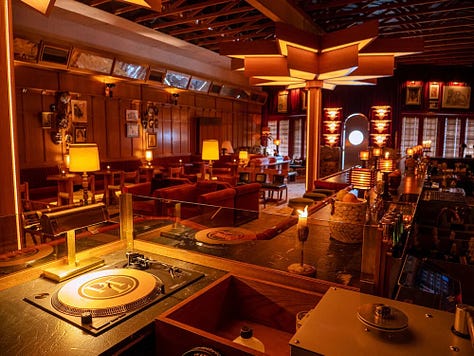
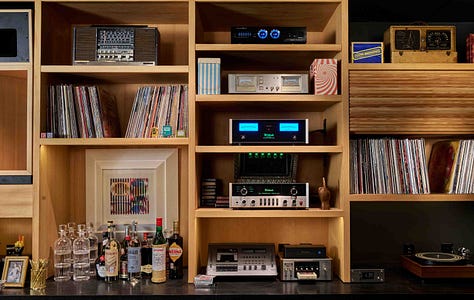
Devon Turnbull, the Brooklyn-based audio engineer who labors under the pen name OJAS, could be considered a sort of patron saint of the new listening aesthetic. He cut his teeth designing the sound system for the lobby of the Ace Hotel in Manhattan, multiple Supreme stores, and the vibe stronghold of Public Records in Brooklyn. He is now a household name among audiophiles and absurdly in-demand, with his signature honeycomb multi-cell horns now a status symbol among those in the know. In 2023, he helped design Honeycomb Hi-Fi in Dubai, the first listening bar in the Middle East.
Through OJAS, Turnbull has created several audio-centric installations which have shown at Lisson Gallery in London and the San Francisco Museum of Modern Art. He has a semi-permanent setup in the back of USM, the Swiss furniture company’s Manhattan showroom. It’s only open on Saturdays from noon until 5pm. I visited the store late on a rainy afternoon a few weeks ago and approached the roped-off entrance to the OJAS space as departing listeners were putting their shoes back on. The lone staffer informed me the room would be closing early that day because he had a flight to catch. I sulked for a moment in a model modular living room and noticed someone had left an open, half-finished package of Oishi strawberries on the coffee table.
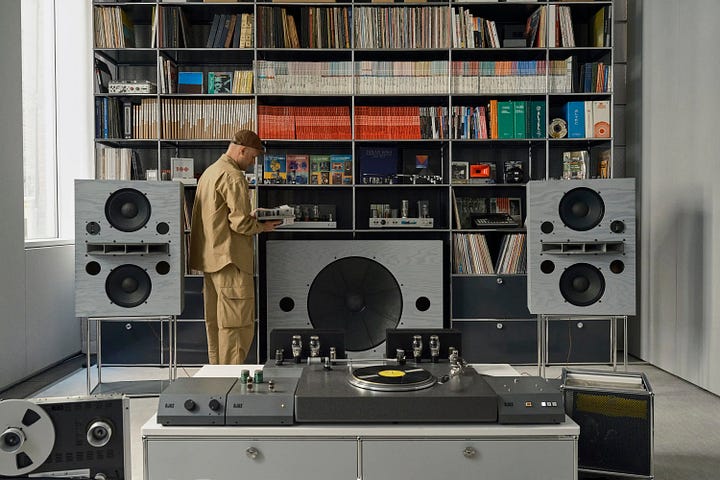
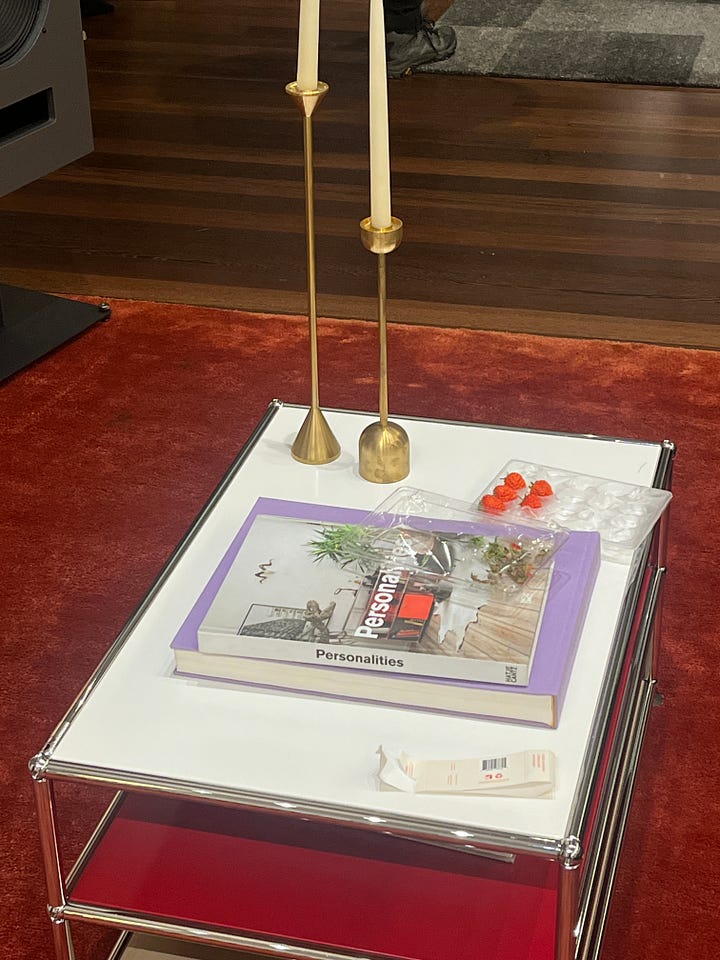
These OJAS activations are not entirely new, conceptually. They are high-profile iterations of a home audio store, with less emphasis on retail (though, crucially, the SFMOMA exhibit sold t-shirts). The onus is on immersion, on building a “shrine to sound” and ostensibly getting people interested in recreating a high-fidelity setup at home. This version of the listening room swings toward an opposite pole: more museum-like in practice, where admission is timed and truncated. You are expected to keep quiet and not stay too long while you’re at it, and there’s no Suntory Premium Malt on draft for $12.
The preciousness of so-called “dedicated” listening has cleaved along a line: hospitality versus practicum. Music has long been deployed as a product within the service industry, never more so than during this listening bar boom. Sound can be as crucial to an establishment’s ambiance and popularity as its lighting. But just like any hospitality product, the way music is deployed in a bar or restaurant follows the paths of trend and is captive to commerce. In researching this piece I found both a flattened aesthetic to most listening bars in the U.S. and a lack of consensus as to what “listening bar” should mean. Some places lean into being part of their city’s nightlife fabric while others try to appeal more to the studied audiophile. It is America after all, an individualist culture particularly when it comes to dining and drinking out. To go against the grain is to fight against two innate cultural impulses: if I’m buying your wares, don’t tell me how to enjoy them and if I hear music I might want to get up to dance and socialize.

Across the broader hospitality industry we’re seeing a rise in “at-home” experience, outside of one’s home. Places aspire to be tastefully eclectic in their decor and overly familiar in their service. Many amateur and entrepreneurial chefs have left the brick and mortar behind entirely, instead focusing on pop-ups and semi-private dinner parties (to the tune of $150 a head or more) in backyards, galleries, or anywhere that signals an absence of white tablecloth. It’s a shrewd tactic: where are people more likely to feel comfortable and satisfied than in their own living room? Partly, this could be viewed as a post-Covid ploy: meet people halfway by giving them something that appears domestic and familiar, but still requires a partial surrender of control over what they’re eating, who they’re meeting, and what they’re listening to. The modern listening bar fits well into this milieu, selling a fantasy of hanging out in your stylish friend’s well-appointed apartment, while some stranger in the party wanders over to the turntable to put on the perfect record.
In one case, the push toward a domestic-style listening bar came at the cost of someone’s actual home. Snail Bar, the uber-popular Oakland natural wine spot, operated for a few years with a very disgruntled upstairs neighbor. Christopher Cantor had lived in his Temescal 2-bedroom apartment for 22 years until the noise level from the floor below forced him to move. Instead of finding a more party-friendly neighbor, Snail Bar’s owners spent well over $300,000 to have the apartment re-zoned (removing its rent-controlled status), and converted into a loungey daytime cafe/nighttime listening bar called Upstairs. In an ongoing lawsuit, Cantor alleges that he was forced to move out due to incessant noise and harassment on the part of Snail Bar and their landlord’s inability to effectively mitigate it. His attorney pointed to a profit motivation for both parties on the other end of the suit: more space means more business for Snail Bar and a commercial lease means higher rent, benefitting the landlord. With regard to Cantor’s plight, owner and head chef Andres Giraldo Florez remarked, “if you’re that sensitive, maybe you should live in the suburbs.”
A few days after Upstairs officially opened back in March, the City of Oakland handed them a cease and desist for failing to obtain proper permits. Upstairs abruptly closed and has still yet to re-open as of this writing. It’s a good reminder, albeit a caustic one, that even the highest-minded version of this type of establishment is still a business, capable of shifting the dynamic of a neighborhood even when it does follow the rules. Prior to the open/close snafu, Florez claimed (boldly) that “I don’t think there’s anything like this in the Bay…I think that hopefully we’ll inspire people to make cooler shit.”
I guess we’ll have to wait and see on that one.
In Sheep’s Clothing started in Los Angeles as an online store, publication, and “source for vinyl & analog culture.” In 2018, they opened a listening bar in the city’s Arts District before closing during the pandemic. In the summer of 2023, they announced a new listening bar and record store in New York, serving both Orion and Guinness on draft and hosting “dedicated listening hours” every Monday from 2-5pm. Briefly, the bar was a hidden gem thanks to its peculiar location in Hudson Square, a made-up neighborhood in Manhattan sandwiched between Tribeca and the West Village. In Sheep’s Clothing NYC operated in a room appendix to Port Sa’id, a restaurant owned by Israeli celebrity chef Eyal Shani. The promise of ISC’s New York outpost was a relatively modest space focused on exploratory curation. The weekly dedicated listening would please the more devout, and feature label and artist-specific selections (International Anthem, Arthur Russell, etc.) The bar fashioned its own little proverb, “to hear more, say less.” A polite instruction that, at least in my handful of visits, people abided by.
Less than a year after opening, it was announced via Instagram that the bar would no longer be operated by In Sheep’s Clothing. It would remain open, but without their involvement or seal of quality. The only explanation, per the ISC account, was that “when we decided to partner on this space, our aim was to provide an environment where listening to records was the focus.” The suggestion being that something, or many somethings, got in the way of that elusive goal and compromised it.
I expect listening bars will continue to dot the American urban landscape, though I don’t believe their continued popularity is a given. Hospitality trends coalesce and then they die, leaving a few stragglers behind. This particular wave has been bolstered by the resurgent growth of vinyl record sales in the U.S., although that market appears to be cooling. Seeing people play records is undoubtedly still popular, even on a sub-cultural level. My Analog Journal, a source for vinyl DJ sets on YouTube started in 2017 by London-based producer Zag Erlat, counts over 1 million subscribers and has inspired a small but robust world of imitators. One of my favorites is Mihon Reko, run out of a tiny bar in Shenzhen, China.
Are the current spate of listening bars actually good for vinyl and analog culture? Again, I think the cultural benefit gets snagged in the industry part of it. Does a city have a strong food culture if it has a lot of great restaurants or if its people are good cooks? Hopefully it’s both. Like a transcendent meal out or seeing a movie in IMAX, the resources and expertise poured into a hi-fi bar can create something impossible to reach in the comforts of your own abode. But that shouldn’t stop anyone who cares enough from creating a space for listening to music at home with the means they have available. Salt the water enough and you can cook pasta pretty good in your own kitchen too.
If listening bars are going to remain a fixture, even a niche one, I hope we’ll start to see more variation in their format and styling. Charis in Chicago describes itself as a “Midwestern Listening Bar,” and signals a looser and more convivial atmosphere. A few miles south, in the city’s Washington Park neighborhood is A Listening Space, part of the 305 E. Garfield complex managed by artist and professor Theaster Gates’ Rebuild Foundation. Currently home to the collection of French-Vietnamese DJ Dinh Nguyen as part of a year-long exhibition, the cafe serves only tea and water at no cost and is described by Gates as “an experimental project to be present and listen deeply.” In the exhibition brief, Rebuild explains that the cafe operates in an anti-capitalist framework, as a communal space “driven by a belief in hospitality as a practice rather than a commercial tool.”
It may be wishful thinking to imagine a proportionate number of anti-capitalist listening bars, particularly in America. But if these places are to survive at all, they must be able to bend and mold to their surroundings rather than rigidly adhering to some theoretical blueprint. Trying to see who can get the closest to the mind-melting sublime of Japan may be a losing enterprise, at least until we learn to keep our voices down.




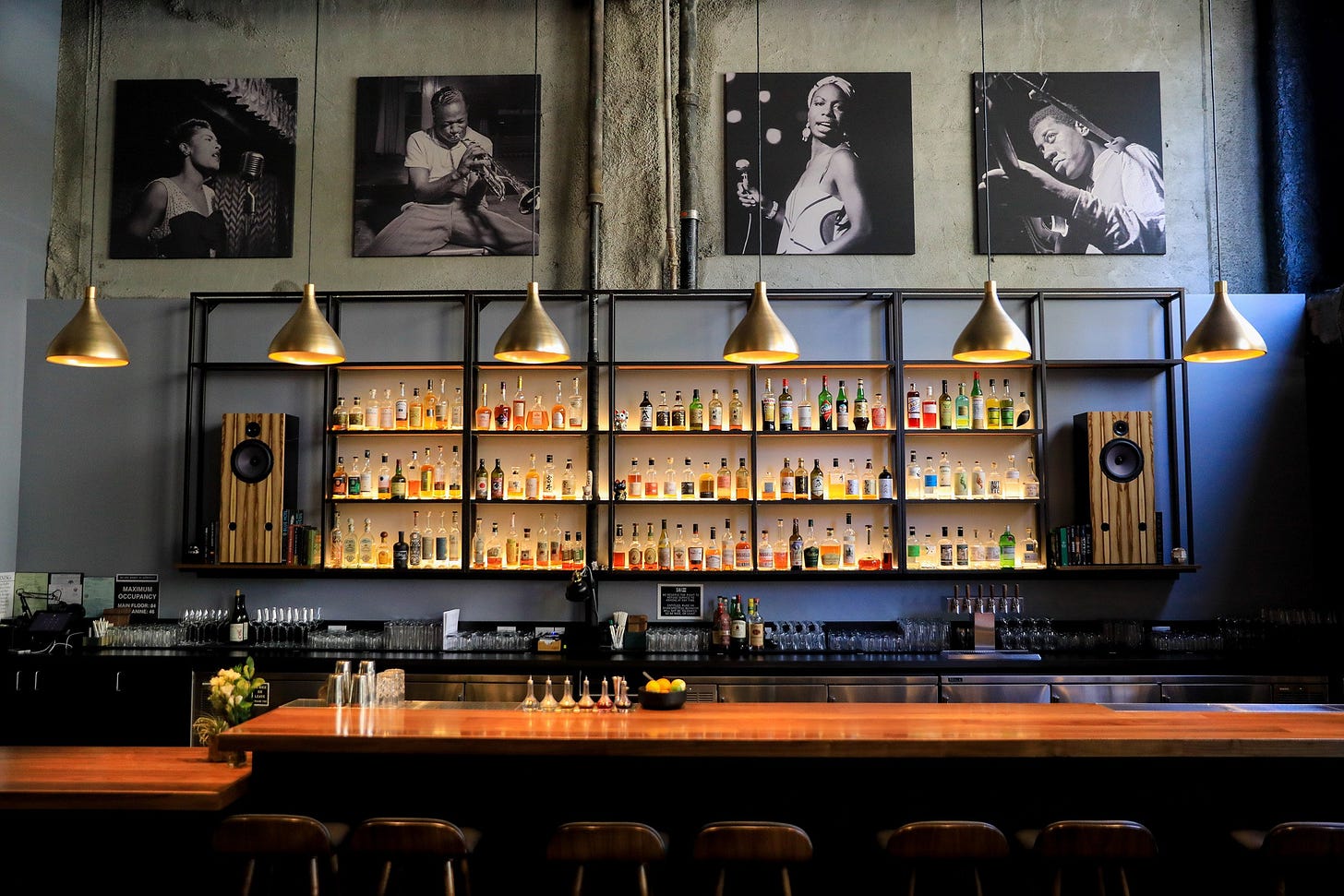
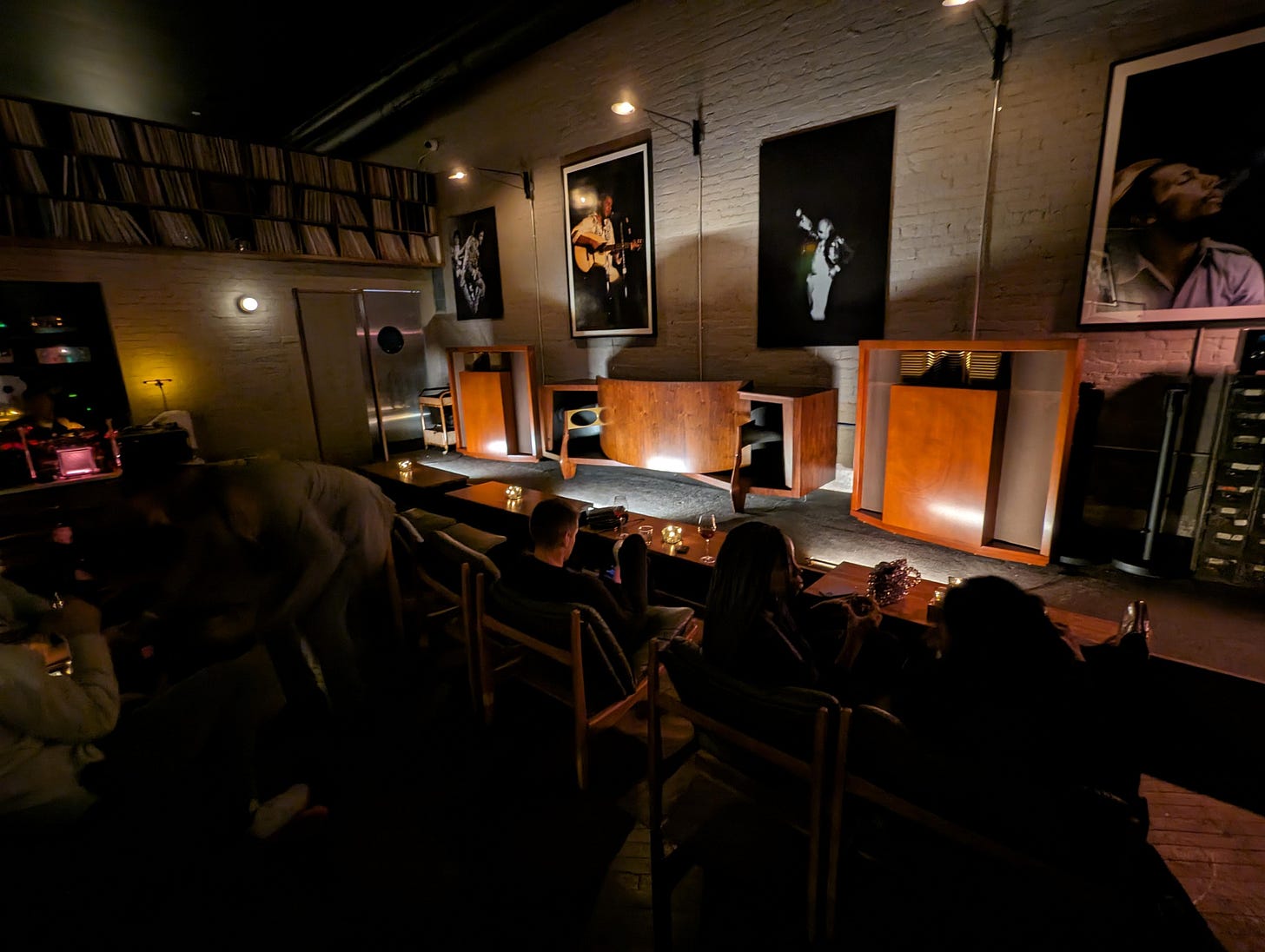
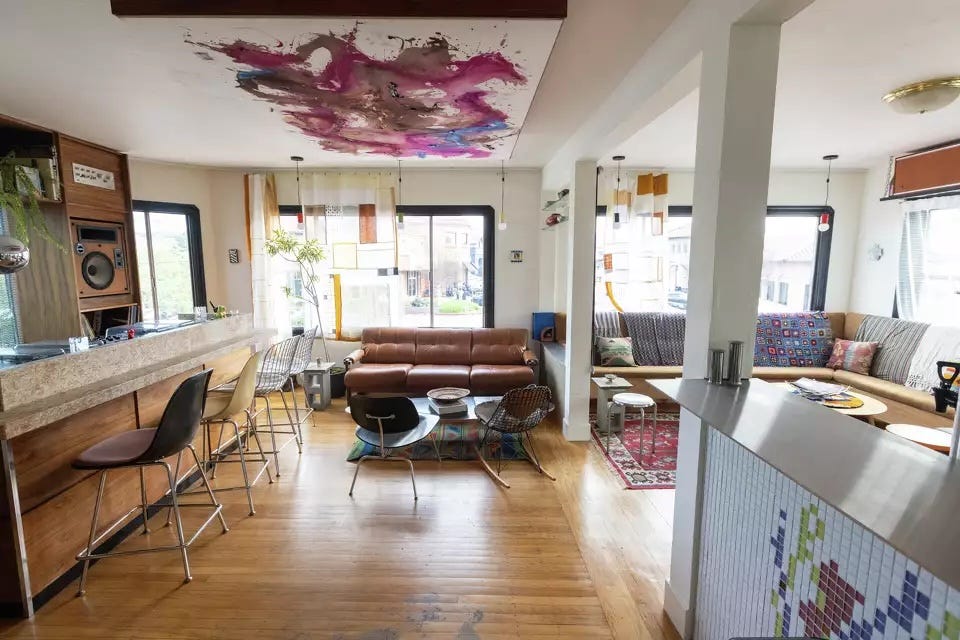
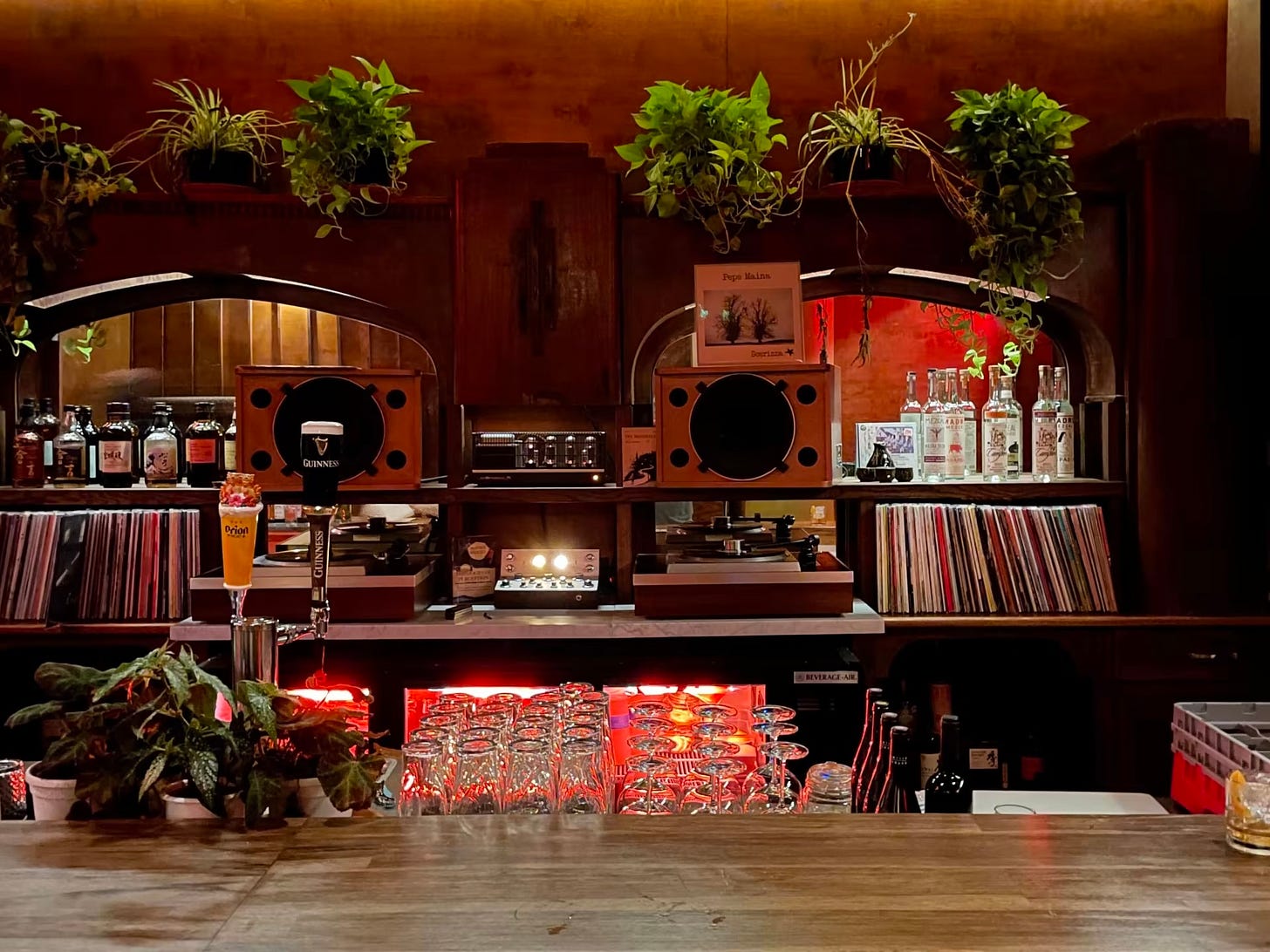
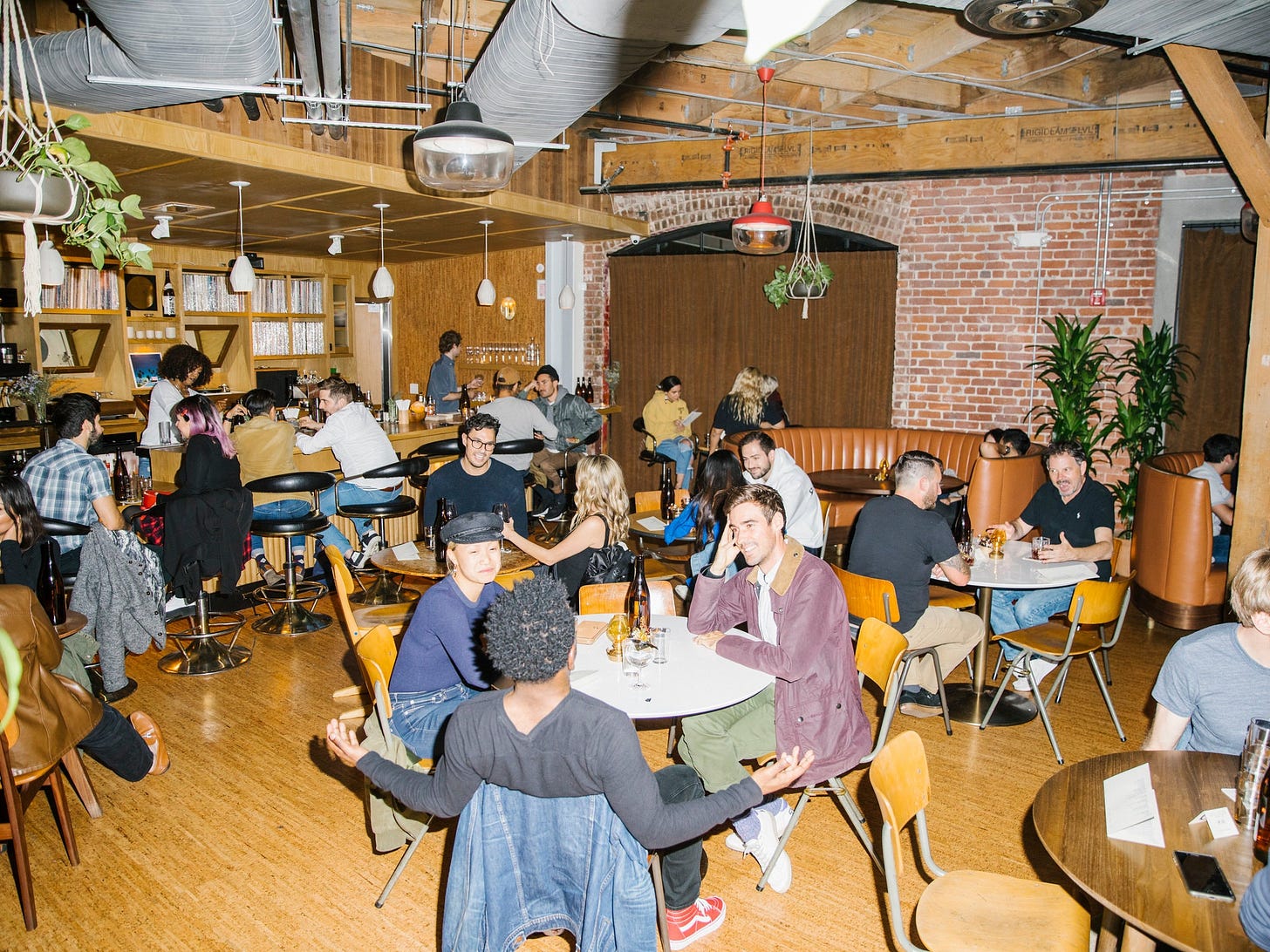
Wow, did not know the background story about Snail Bar! As a DJ, former law student and someone with friends who frequent Snail Bar, this piece resonates!
Worth noting that the Gold Line bar in Highland Park, Los Angeles also opened around the same time in 2018. Stocked with records from Peanut Butter Wolf, founder of Stones Throw Records. His whole milieu definitely contributed to the vinyl DJ/producer scene. I think they were definitely influence by Japanese listening bar culture for sure.
Japanophilia kind of makes me sick in general but I appreciate you drawing these connections!
Such a great rundown. The interior design of this spaces is an article in itself. Thanks, Riley.